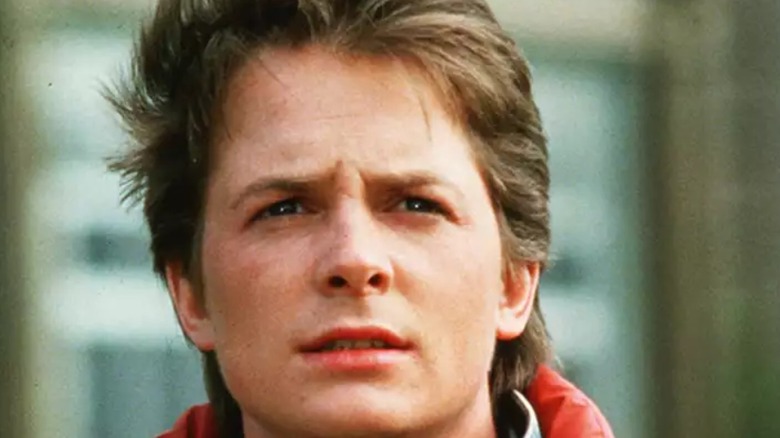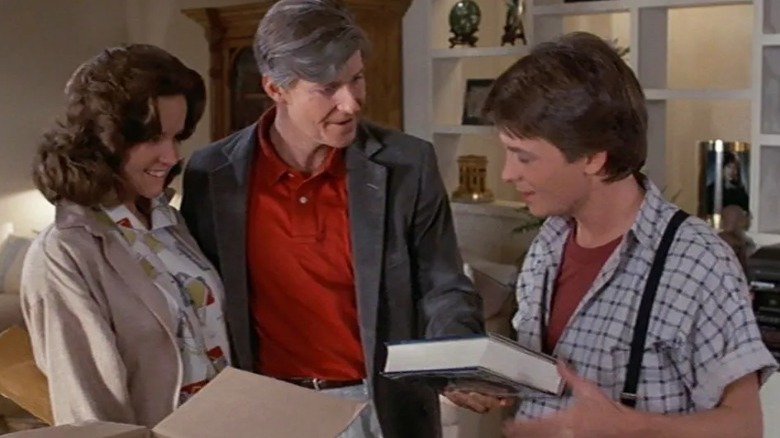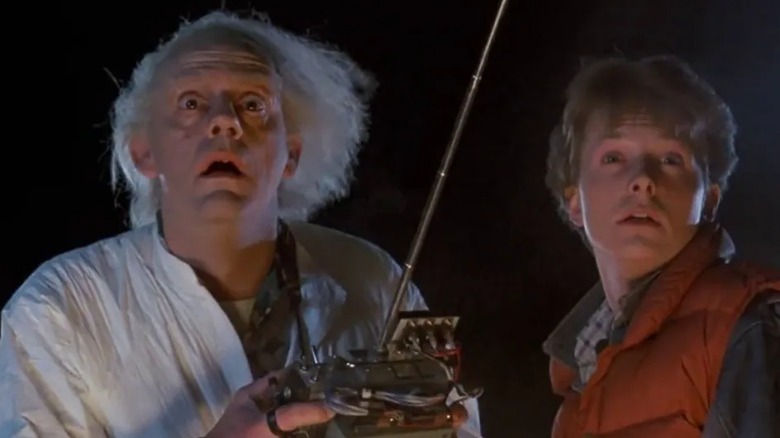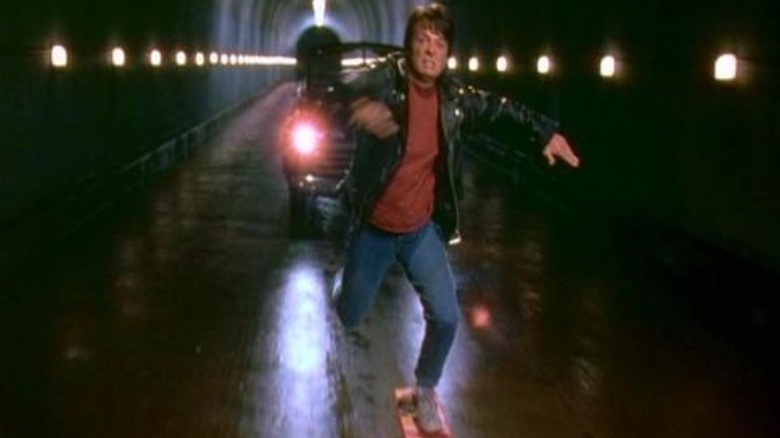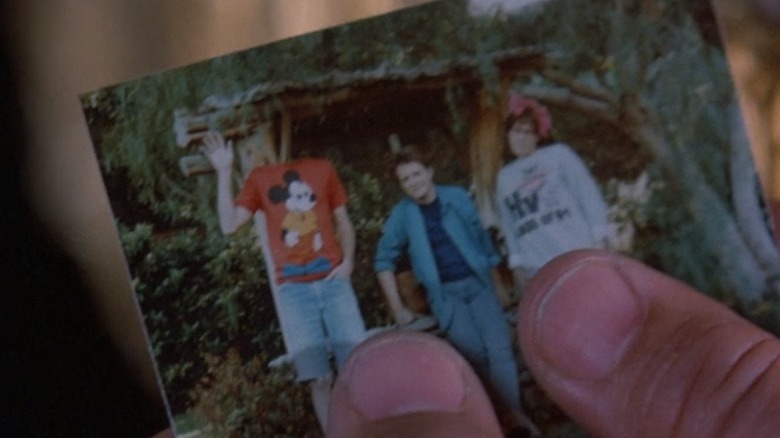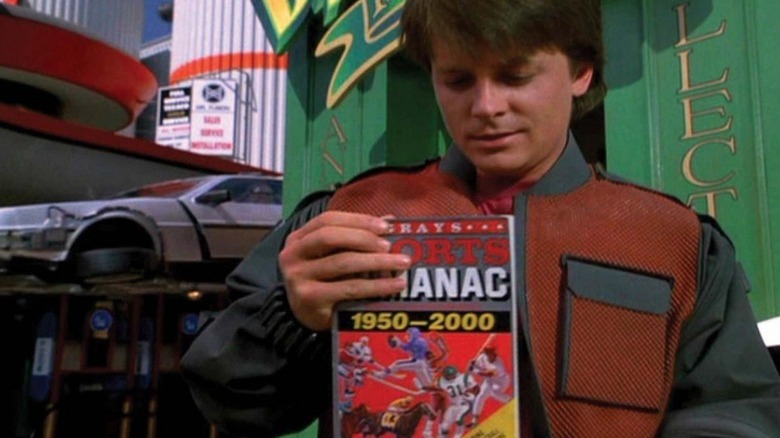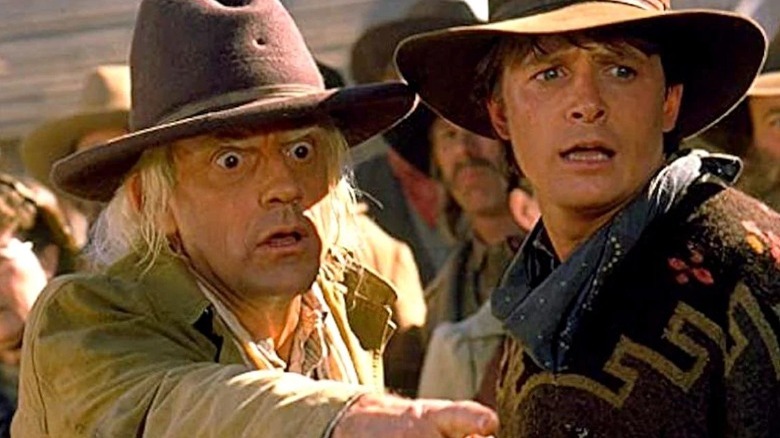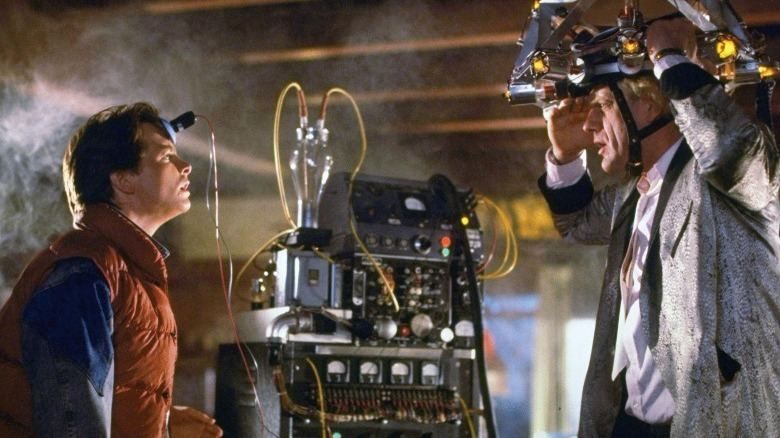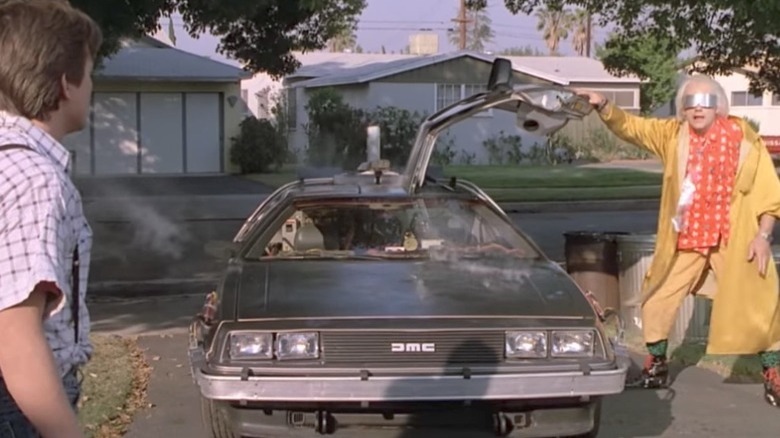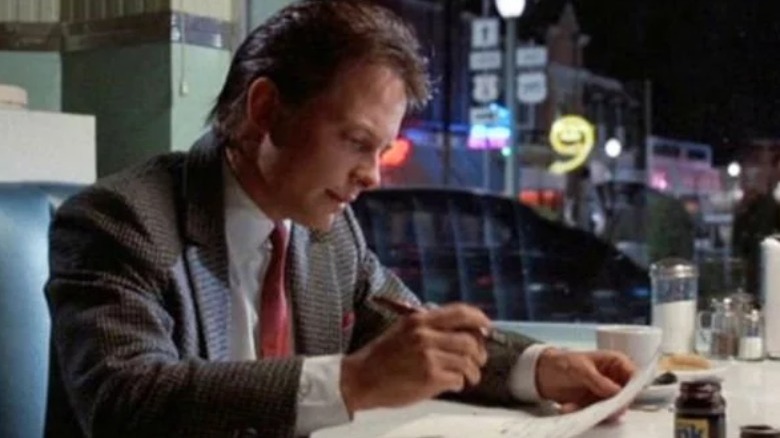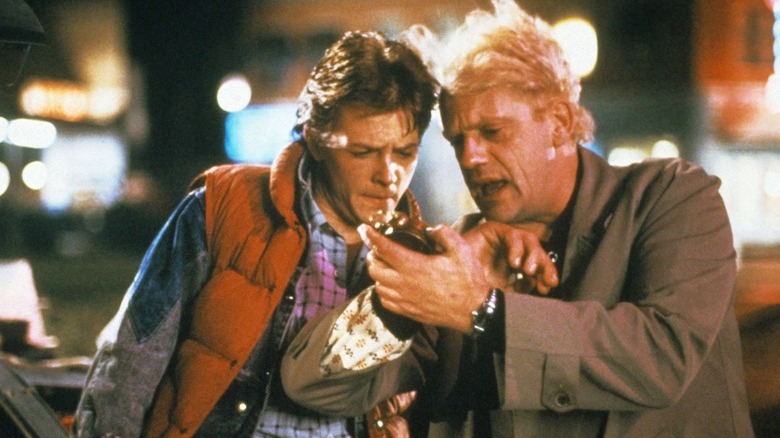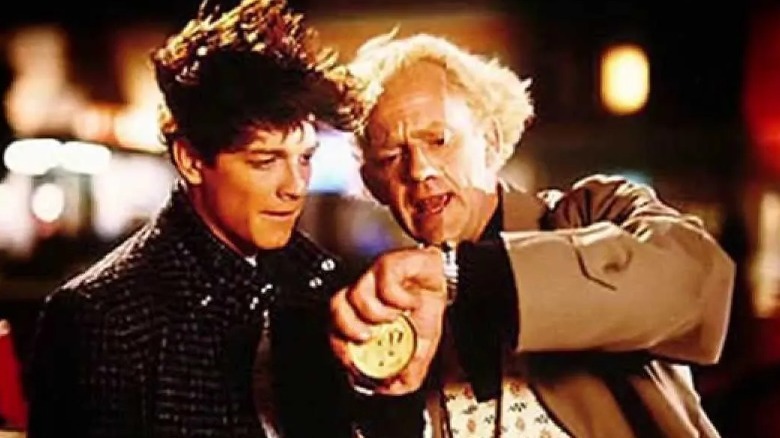The Craziest Back To The Future Fan Theories That Change Absolutely Everything
Most likely, the mere words "Back to the Future" get the theme song buzzing in your head, the desire filling you to lift the door of your make-believe DeLorean, sit in the driver's seat, and burn rubber at 88 miles per hour. In the '80s and early '90s, the Robert Zemeckis-directed trilogy topped the box office with Marty McFly and Doc Brown's tumultuous adventures in the past, alternate present, and future — yet somehow, their popularity seems to have only grown with each passing year.
The films are genuine classics, and decades later, still garner so much interest that fans scrutinize scenes and lines, often debating their meanings. Much of this is due to how Zemeckis and crew paid extra-close attention to small details; have you ever noticed that the Two Pines mall at the beginning of the first film becomes Lone Pine mall by the end because Marty ran over one of two pine trees in the past that marked the location for the future outlet? It's just one of the subtle but brilliant details that addresses the repercussions of time travel while rewarding viewers willing to go "Back" again.
Some "Back to the Future" theories are absurd; others are intriguing and may just change how you view Marty's misadventures. So let's fire up the flux capacitor and take a trip where we don't need any roads, breaking down series plot points that may (or may not) be intentional.
Marty's parents knew he time traveled
As the smoke cleared on the first "Back to the Future" film, a question quickly presented itself: how do Marty's parents not recognize him as the Calvin Klein/Marty who was so significant in bringing them together?
Aside from the physical resemblance, Marty name-drops Darth Vader and references Spock's home world, Vulcan. Then there are the winking-at-the-audience moments, like when Marty asks his future parents to go easy on any future child of theirs who might accidentally set fire to their rug.
One popular fan theory suggests that George came to believe, at some point in his life, that Marty was his son from the future. The advent of "Star Wars" and "Star Trek," which George would most certainly adore given his love for all things sci-fi, would cause him to reflect. When their future child did set the carpet on fire, that would at the very least feel like a Nostradamus moment, and how could George not suspect time travel once the real Calvin Klein became famous?
According to this theory, George and Lorraine never discussed time travel with their son because they didn't want to interfere with the timeline. At the end of the first film, you may recall that George tells Marty that he can accomplish anything he sets his mind on. Then when Marty is meeting Jennifer in the driveway, both Lorraine and George are seen watching and smiling — an indication that they know he's just returned from 1955.
Doc Brown kills Marty
Some "Back to the Future" fan theories can get pretty dark. For example, one suggests that Doc Brown had to kill Marty to prevent a paradox.
According to this theory, after the good doctor sent Marty into the past, Marty contacted the Doc Brown of 1955 in order to help him repair his future time-traveling invention. Before returning to 1985, Marty wrote Doc a letter warning him of his impending death at the hands of terrorists.
Marty returned to the present day moments before his initial journey into the past. Doc was once again gunned down by the terrorists, but he survived the attack because he read Marty's letter warning him. Furthermore, Doc now has an enduring memory of Marty in the past; he's waited decades for the moment the Marty he talked to in 1955 would return.
According to this theory, the Marty that went to 1955 would then follow an infinite loop of returning to 1985 and seeing his past self escape once again — a loop Doc Brown closed by sending the "second" Marty to oblivion.
The reasoning behind all this is that Doc strongly believed that if an individual met themselves, that paradox would result in the destruction of everything. Because there would be an infinite loop of two versions of Marty coming close together, there would be infinite possibilities for them to meet, so Doc plotted to close the loop by sending the second Marty to his death. That'd be a rather grim secret to keep from the current Marty.
Marty probably died at least once
In "Back to the Future Part II," It's up to Marty to find and retrieve a sports almanac from Biff Tannen in 1955 before he can live a life of "good luck," raking in millions by betting on sporting events. Marty nabs the book and attempts to escape on his hoverboard while Biff pursues him in his car, hellbent on running Marty down. At one point, Marty finds himself inside a tunnel where Biff comes dangerously close to killing him, but a rope drops at the last minute, lifting him to safety. Marty's savior? Doc Brown, hovering above in the DeLorean.
While most viewers probably enjoyed the thrill of the moment, others considered a question it presents: How did Doc Brown know exactly when and where to find Marty? One fan theory argues that Marty is actually killed by Biff in the pursuit, and although Doc has a rule against interfering with time, he'd break it to save his friend's life. Knowing where and when Marty is fated to die, then, Doc could travel to the right time and place to rescue him — and would never mention any of it for fear of upsetting the space/time continuum.
Marty changed how Doc perceived time
Inexplicably, Doc Brown went against all of his principles, repairing and reading the torn letter that Marty left him about his future death. When Marty was confused by the change in Doc's outlook on negatively impacting the future, Doc simply responded: "I figured 'What the hell.'" That's a non-answer; but if you think about it, it's easy to see how Doc Brown had his change of heart.
After Marty brought his parents together, he raced back to Doc in order to make his trip back home to 1985. He excitedly told Doc how everything worked and even explained that George had knocked Biff out with a killer right hook — even though, in the original timeline, his father had never stood up to Biff in his entire life. Doc closely examined the picture of Marty's siblings, seeing that it had been restored, and asked Marty, "Never?"
In that moment, Doc seemed to brush it off. But according to one theory, after seeing Marty's family restored for the better, he hypothesized that altering the past doesn't always have to produce negative consequences. Freed of his worry, he repaired the letter. What the hell, right?
The ever-changing sports almanac
According to the rules of the "Back to the Future" universe, Biff's theft of the sports almanac and subsequent delivery to his younger self should have had all sorts of unpredictable ripple effects on the timeline, but one Redditor has explained how the almanac is nearly foolproof. Just as the picture of Marty and his siblings in the first film was altered based on the changing timeline, this theory suggests that the same would hold true for the almanac — if the outcomes listed in the original almanac were altered, the book would simply change to reflect that.
The only way to truly stifle Biff's plan (aside from taking back the book) would be to fix the outcome of a sporting event after Biff had already placed his bet. That would involve even more time-traveling that could actually backfire depending on how the flow of time is perceived. Because this plan is so dicey, the one Marty cooked up was the best (and certainly the most entertaining) way to go.
Doc Brown invented technology used in the present
With Doc Brown settling in 1885 and planning to live out the rest of his days there, the future was always destined to change — even though he's ready for life in the 19th century, that doesn't mean his scientific curiosity will go away. Given his knowledge of future tools and methods, there's no way he won't end up inventing things that will alter the course of human history.
A theory on Reddit argues that by the end of "Back to the Future Part III," Doc has already started down this path. While rather bulky and complex, he's constructed his own refrigeration unit where he can create a single ice cube, and he's also developed a scope for his rifle. At the beginning of "Part III," the 1955 Doc Brown wonders if he's now part of the history books. There's no doubt that he made a splash in the world of science with inventions, like refrigeration, which will become a part of daily life in the 20th century.
The Lockard theory
Film critic Robert Lockard proposed this idea, which became known as "the Lockard theory." He believes that the entire "Back to the Future" trilogy is actually a chiasmus — a symmetrical structure of storytelling in which whatever happens in the beginning also happens in the end. There's a central pivotal moment, after which the back half of the film (or trilogy, in this case) is a mirror reflection of the first half. Much like the symmetry found in the flux capacitor, this holds true in many cases with the "Back to the Future" movies.
The moment this trilogy pivots into its mirror image occurs in the middle of the second film, when Marty discovers his home is no longer his. Doc explains to him that the timeline has been changed; a short while later, Biff tells Marty how he altered the timeline, then attempts to shoot him. At either end of the trilogy, the first and final time that the DeLorean travels through time, its license plate is seen left behind, spinning in the road. The entirety of Lockard's theory about the "Back to the Future" movies — and many examples of symmetrical storytelling — can be found here. Take a look and decide for yourself.
The DeLorean refused to create paradoxes
Doc is adamant that neither he nor Marty should do anything to create time paradoxes that could destabilize the space time continuum — it's practically the number one rule of time travel. Thankfully, Doc's time machine appears to go out of its way to avoid moments that are dangerously close to paradox territory.
While multiple examples of this theory can be seen throughout the trilogy, the best come in the first film, like when the DeLorean breaks down in a remote location outside of the future Lyon Estates where the public won't see it. Of course, if someone from 1955 laid eyes on the vehicle, they'd begin asking questions. At the end of the film, Marty manages to hit the wire at the exact moment lightning strikes — despite the car failing to start right away. This has led many to wonder if the vehicle somehow corrected the timing to account for a mistake in Doc Brown's calculations. Additionally, if the vehicle didn't stall again after Marty returned to 1985, he might've arrived at the mall too early and met his younger self, thereby creating another paradox.
Marty thought twice about writing the letter
At the end of the first film, Marty realizes he has to tell Doc about his future death even if he doesn't want to hear it, and decides to write it all down in a letter. Doc shreds the letter in front of Marty, and when Marty returns to 1985, he rushes to save Doc but it's too late — his attackers have already gunned him down. However, it's revealed that Doc's still alive, thanks to a bulletproof vest that he wore because he reassembled the torn letter and heeded the warning.
Eagle-eyed viewers will notice, however, that the letter Doc Brown shows Marty and the letter we saw Marty writing aren't the same. Some of the writing is different and the underline in the signature is in a different place. While most might chalk this up to a simple filmmaking error, fans have suggested that it is, in fact, an intentionally subtle detail that suggests Marty was conflicted. He obviously wanted Doc to be spared from certain death, but Doc had consistently warned Marty of the dangers of altering the timeline. According to this fan theory, Marty wrote a letter, scrapped it, and then wrote another one when he finally decided he had to try and save his friend's life.
Doc already time-traveled before the first film
Doc Brown and Marty spend most of their time-traveling excursions fixing problems that they themselves caused in the first place. Of course, the eccentric scientist claims to be cautious and warns against timeline alterations. But isn't time-travel itself tampering with the space/time continuum?
One fan suggests that Doc already time-traveled before the events of the first film, and that the movie is simply a "divergent timeline" where the spunky scientist attempts to fix his mistakes. This theory takes into account the fact that in the film's introduction viewers can see a newspaper clipping indicating that Doc's estate burned down many years prior and that he had to sell the land. Additionally, all of his clocks are 25 minutes slow as Doc points out to Marty. This is enough evidence for a Redditor to suggest that Doc had already time-traveled. This time, however, he is attempting to re-write his own history and build a new instance for his discovery of time-travel which he'd ensure is fully documented with the help of Marty.
A lot of thought was put into this fan-baked theory, so be sure to check out the original Reddit posting. Regardless, everything seems to fit like a glove and could be a possible explanation for Doc's "unidentified" experiment that he mentions to Marty on the phone at the beginning of the film. How about a "Back to the Future" prequel? Any takers? Probably not.
Eric Stoltz is the actor punching Biff, not Michael J. Fox
As some fans of the franchise may know, Michael J. Fox wasn't the original Marty McFly. In the Netflix documentary series "The Movies that Made Us," Bob Gale states that Fox was always the actor they wanted for the role. However, Fox's "Family Ties" fame made him unavailable, so Universal suggested Eric Stoltz ("Mask," "Pulp Fiction") as a replacement. Early scenes of the movie were shot with Stoltz, but when he just didn't seem like the right fit, Fox signed on for the role and the rest is history.
Multiple scenes, however, had to be reshot with the new leading man. One fan theory posits that the quick scene in the theatrical release of the film where Marty punches Biff is actually Stoltz's fist and not Fox's. The Hollywood Reporter got in touch with the film's co-creator Bob Gale in an effort to settle this long-running theory once and for all, but Gale explained why the theory must go unsolved.
One of the film's editors confirmed that the punch scene was, in fact, reshot. However, some Stoltz takes were labeled as being okay to use, meaning that the original shot of Stoltz still could've been used in the editing process. Gale claims that the only way that the theory could be settled would be to look at the markings on the actual negatives — something no one will do, for fear of damaging a piece of Hollywood history.
